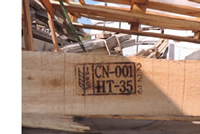
19th Meeting of the Panel on Quarantine Pests for Forestry
Vienna, 2014-03-10/12
The Panel revised the EPPO Standard PM 8/2 Commodity-specific phytosanitary measures for Coniferae and agreed to send the revision for country consultation. The Panel considered that in some cases PRAs should be conducted for a pathogen and a vector at the same time because they cannot cause significant damage alone. The Panel concluded that the commodity ‘pine cones’ could be a pathway for Gibberella circinata and that appropriate measures for this pathway could be ‘pest-free area’ and ‘heat treatment to 56°C for 30 min’.

Participants - View more pictures »
The Panel considered pests of Buxus: Cydalima perspectalis, Cylindrocladium buxicola and Rotylenchus buxophilus the first two of which have been deleted from the EPPO Alert List but now are causing serious damage in several areas of the EPPO region. The Panel concluded that it is not possible to stop the spread of these two pests and that deletion from the Alert List does not mean that the pest is no longer important, and measures could still be applied by NPPOs. The Panel needed more information on Rotylenchus buxophilus.
The Panel considered pests of forestry concern in the updated EPPO Alert List and provided recommendations on them. The Panel recommended deleting Aproceros leucopoda, Chalara fraxinea, Chrysophtharta bimaculata and Pseudomonas syringae pv. aesculi from the Alert List. The Panel recommended conducting PRA for Thousand cankers disease (Geosmithia morbida and Pityophthorus juglandis). The Panel suggested considering Euwallacea fornicata/Fusarium euwallaceae, Phyllobius intrusus and Phytophthora austrocedrae for their potential inclusion in the EPPO Alert List.

The Panel considered the specific issue of urban trees and agreed that it is an important phytosanitary problem as a lot of tree pests enter and establish on urban trees before moving to forests. The Panel noted important differences between EPPO countries in urban tree situations and responsibilities, and considered the possibility of organizing an EPPO Workshop on this issue. The Panel also decided that EPPO should develop an official declaration that would help countries to intensify research on urban trees and to pay more attention to this issue.
The Panel considered possibilities for collaboration with the NAPPO Forestry Panel and agreed that the exchange of experts for regular EPPO and NAPPO forestry meetings would be a good initiative.
The Panel was informed about the start of the EPPO Study on non-manufactured wood commodities aiming to classify such commodities, to provide their definitions and to summarize possible phytosanitary measures.
 The Panel considered the EPPO Standard PM 3/53 Fermenting (composting) of bark of conifers and suggested withdrawal of this Standard because the key mechanism for disinfestation is heat, which is covered by separate standards. The Panel also considered possibilities to develop strategies for ‘pest-free areas’ option for bark beetles. The Panel decided that such strategies are possible only on a case by case basis and agreed to develop such a pest-specific strategy for Polygraphus proximus for consideration at the next meeting.
The Panel considered the EPPO Standard PM 3/53 Fermenting (composting) of bark of conifers and suggested withdrawal of this Standard because the key mechanism for disinfestation is heat, which is covered by separate standards. The Panel also considered possibilities to develop strategies for ‘pest-free areas’ option for bark beetles. The Panel decided that such strategies are possible only on a case by case basis and agreed to develop such a pest-specific strategy for Polygraphus proximus for consideration at the next meeting.
The Panel considered the possibilities of classical biological control of forest pests and concluded that the use of biological control agents could be useful in slowing down the spread and reducing damage caused by forest pests but needed preliminary study and checks for safety.
